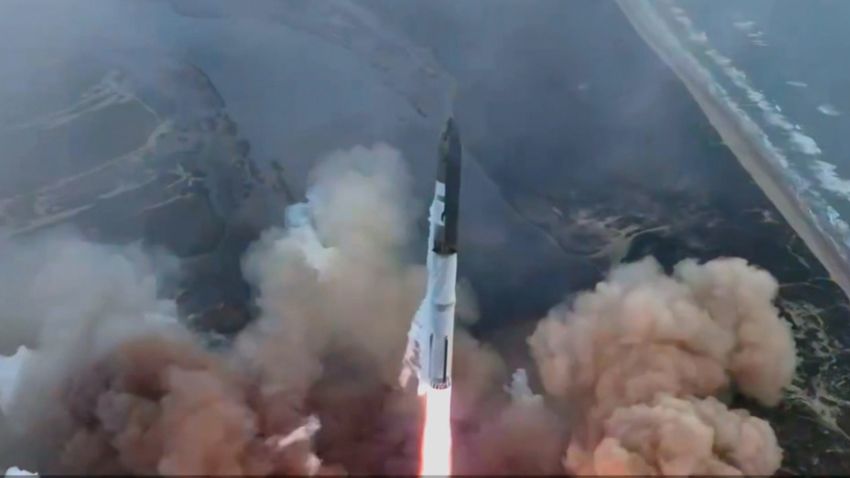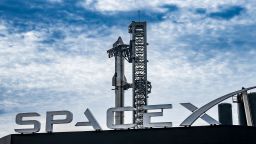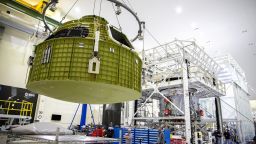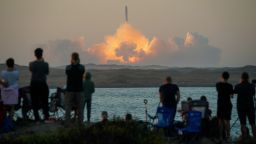Editor’s note: Follow along with CNN’s live updates of the SpaceX Starship launch.
A SpaceX Starship rocket launched on its third test flight from the Starbase facility in Boca Chica, Texas, and achieved multiple milestones Thursday morning before likely breaking apart.
The deep-space rocket system went through nearly an hour-long integrated flight test. The spacecraft was expected to splash down in the Indian Ocean at the conclusion of the flight, putting the gargantuan vehicle in a position to move on to more complex test flights and, eventually, carry NASA astronauts to the moon’s surface.
But after reentry the team lost two key pieces of communication at the same time: Contact with Starlink, SpaceX’s internet service, and with TDRSS — or Tracking and Data Relay Satellite System.
“The team has made the call that the ship has been lost, so no splashdown today,” said Dan Huot, SpaceX communications manager, during the live broadcast. “But again, just it’s incredible to see how much further we got this time around.”
SpaceX also never intended to recover Starship after this flight test. The spacecraft was expected to make a hard landing. And the Starship spacecraft made it much farther into flight than during two previous tests in 2023.
The company routinely frames failures during these early test flights as normal. The goal of these flight tests is to gather crucial data so that engineers can go back and tinker with Starship, improving it for future missions.
The Starship vehicle — which includes the upper Starship spacecraft and a rocket booster known as the Super Heavy — took off from SpaceX’s private Starbase facility in Boca Chica, Texas, at 8:25 a.m. CT (9:25 a.m. ET).
SpaceX considers the Starship system crucial to its founding mission: to carry humans to Mars for the first time. And critically, NASA has chosen Starship as the landing vehicle that will ferry its astronauts to the lunar surface on the Artemis III mission slated to take off as soon as September 2026.
“Congrats to SpaceX on a successful test flight! Starship has soared into the heavens. Together, we are making great strides through Artemis to return humanity to the Moon— then look onward to Mars,” wrote NASA Administrator Bill Nelson on X, formerly known as Twitter.
The Super Heavy booster — the first stage, or bottommost part, of the launch vehicle roared to life and soared out over the Gulf of Mexico.
The Super Heavy booster burned through most of its fuel and broke away from the Starship spacecraft, the upper stage that rides atop the Super Heavy.
The booster was expected to make an autonomous, controlled landing in the ocean, but the booster “didn’t light all the engines that we expected and we did lose the booster,” Huot said.
SpaceX said it’s working to get video of what occurred before the booster hit the water. But the the booster made it farther into flight than a Super Heavy booster has previously made it. On the past two flights, Super Heavy was destroyed midair before it had a chance to try out landing maneuvers.
Meanwhile, the Federal Aviation Administration will investigate the “mishap” involving both the Super Heavy booster and the Starship spacecraft. The agency licenses commercial rocket launches and oversees mishap investigations when spacecraft are lost during flight. Such investigations are routine and carried out whether or not SpaceX expects a loss of the vehicle.
“A mishap occurred during the SpaceX Starship OFT-3 mission that launched from Boca Chica, Texas, on March 14,” according to a statement released by the FAA. “No public injuries or public property damage have been reported. The FAA is overseeing the SpaceX-led mishap investigation to ensure the company complies with its FAA-approved mishap investigation plan and other regulatory requirements.”
The third test flight occurred on SpaceX’s 22nd anniversary, according to the livestream.
Aiming for orbital speeds
SpaceX CEO Elon Musk has said a primary goal of these early test flights is to get Starship to orbital speeds — velocities quick enough to allow the spacecraft to enter a stable orbit around Earth.
Typically, such a feat requires speeds topping 17,500 miles per hour (28,000 kilometers per hour).
Starship reached its orbital speeds goal and did not aim to actually enter orbit on this flight.
Starship tests and tech demos
Starship burned its engine for about six minutes before it entered a coasting phase. The spacecraft ran through a few key tests and tech demonstrations.
First, Starship reached speeds close to what would be required to put the vehicle in orbit. The Starship’s payload door — a hatch that must open for the spacecraft to deploy satellites into space after reaching orbit — also swung open before resealing in a crucial test of that mechanism.
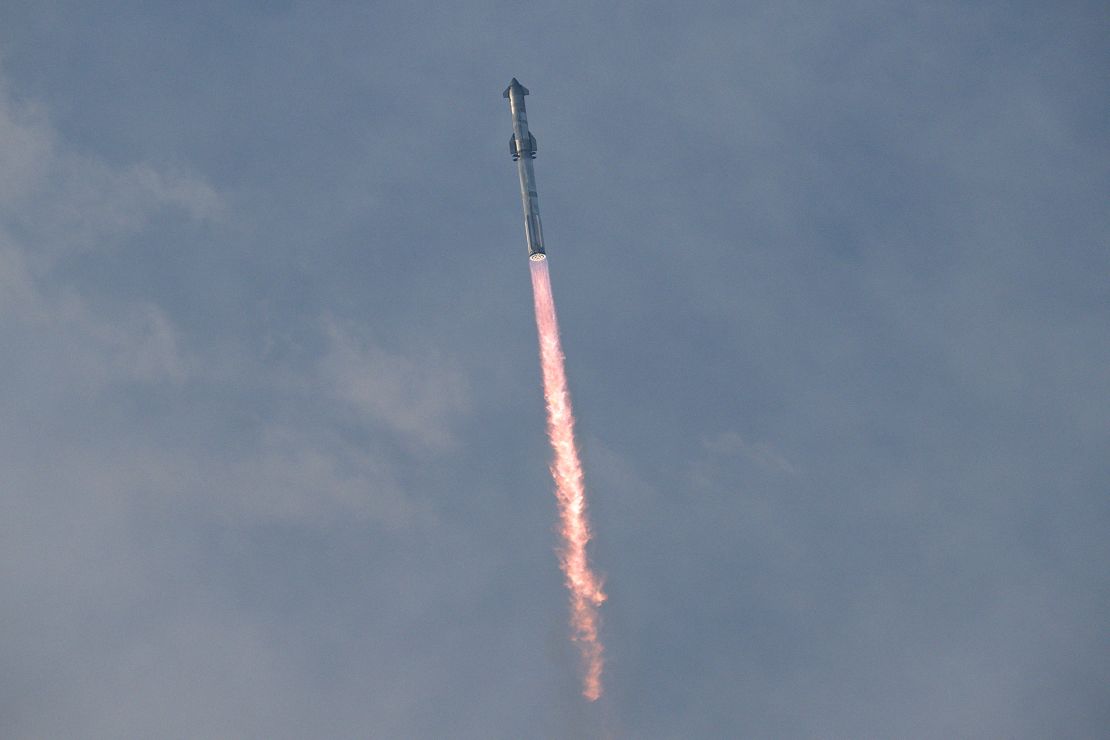
SpaceX also carried out what the company is calling a “propellant transfer demonstration.” The goal was to move some of the propellant on board the Starship vehicle from one tank to another, according to a December email from NASA explaining the test.
SpaceX engineers designed that demo to begin hashing out how Starship will be refueled on future missions while it’s in orbit.
The team will “need to do some data review” of both the payload door opening and the propellant transfer demonstration to determine how successful each test was, according to the live broadcast.
However, after reaching several milestones, SpaceX revealed it opted not to attempt to reignite Starship’s engines after a half-hour coasting phase that was originally planned for the flight test.
Starship was on a “pretty steep trajectory,” Huot said. That meant Earth’s gravity would likelrapidly drag Starship back toward Earth, whether or not engines are relit.
It’s not clear why SpaceX decided to forgo that test, but engineers noted a lot of data needs to be evaluated in the hours and days ahead.
“The atmosphere is actually doing us a huge favor here by acting as a braking system for starship,” said Kate Tice, one of the hosts of SpaceX’s livestream.
The Starship spacecraft is coated in about 18,000 lightweight, ceramic hexagon tiles designed to protect the vehicle from the scorching-hot temperatures as it plunges back into the Earth’s atmosphere.
During the livestream, a vibrant halo of bright red plasma, created by extreme heat and pressure as Starship entered the atmosphere, could be seen glowing around the vehicle.
Shortly after, the team lost communication with the spacecraft.
NASA Artemis moon mission
Topping off the spacecraft’s fuel will be critical for Starship’s high-profile missions down the road.
When Starship makes a journey to the moon under NASA’s Artemis program — it will have to sit in orbit close to Earth as SpaceX launches separate vehicles that will transport only fuel to the spacecraft. To get to the moon, SpaceX may have to make more than a dozen refueling trips.
SpaceX received approval from regulators on Wednesday to carry out this latest test flight.
SpaceX’s explosive test-flight process
Musk has said he was more confident this flight will be successful compared with the 2023 attempts. A success would potentially give the company crucial data that could allow Starship to move on to more difficult test flights.
“I don’t want to jinx it, but I think the probability of reaching orbit is good — 80%,” he said during a recent talk posted to social media. “Certainly the third flight is a much better rocket than flights one or two.”
Still, SpaceX officials have repeatedly said the company does not expect 100% accuracy on these early test flights.
“Each of these flight tests continue to be just that: a test. They aren’t occurring in a lab or on a test stand, but are putting flight hardware in a flight environment to maximize learning,” the company said in a statement posted to its website. “This rapid iterative development approach has been the basis for all of SpaceX’s major innovative advancements.”
Sign up for CNN’s Wonder Theory science newsletter. Explore the universe with news on fascinating discoveries, scientific advancements and more.


